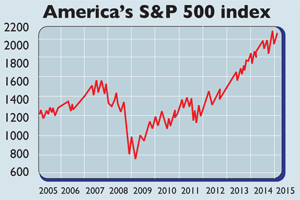
After a shaky start to the year, stockmarkets have hit new highs. America’s S&P 500 index, which usually sets the global tone, has hit a new record around 2,100. Positive data in Europe and optimism over potential deals in Ukraine and Greece have bolstered stocks. Liquidity continues to provide a lift too, of course. According to Evercore ISI, an investment bank, central banks across the world have loosened monetary policy 514 times in the past three years.
All this is just as well as far as the S&P is concerned, because the outlook for US earnings has deteriorated. Around four-fifths of the S&P’s 500 firms have now reported their profits for the final quarter of 2014. So far, profits have grown by around 4.1% year-on-year, while sales have expanded by 1.6%. Strip out Apple, and earnings are growing at less than 2%.
The 50% drop in the oil price has hurt the energy sector, which makes up almost 10% of the index. Meanwhile, “the strong dollar is hurting”, notes Société Générale’s Albert Edwards. The greenback has risen to a ten-year high against a basket of America’s major trading partners’ currencies. That is undermining S&P companies’ foreign sales, which are worth half of total revenues.
Last April, analysts were pencilling in year-on-year earnings growth of 14% in the first quarter of 2015. Now they are expecting a fall of 1.4%. At the start of 2015 the forecast was still 5.3%. Similarly, six weeks ago Wall Street expected earnings growth of 8.1% in 2015 as a whole. Now that has been slashed to 2.6%.
It’s also worrying, says the FT’s John Authers, that margins are historically high. Sales growth has been anaemic in this recovery, with earnings growing faster than sales in every quarter but one since the crisis. Firms have been able to boost profits by driving down costs, but this may become harder as wages finally appear to be climbing.
All this would matter less if the S&P weren’t priced for perfection. The forward price/earnings (p/e) ratio is at a ten-year high of just under 17. The cyclically adjusted p/e is 26, far above the long-term average of 18. An overvalued market is more vulnerable to disappointments.
“We have a combination of cyclically high profits, a downward trend in [earnings] revisions and above-average valuations,” says economist.com’s Buttonwood blog. “That ought to be cause for concern.”